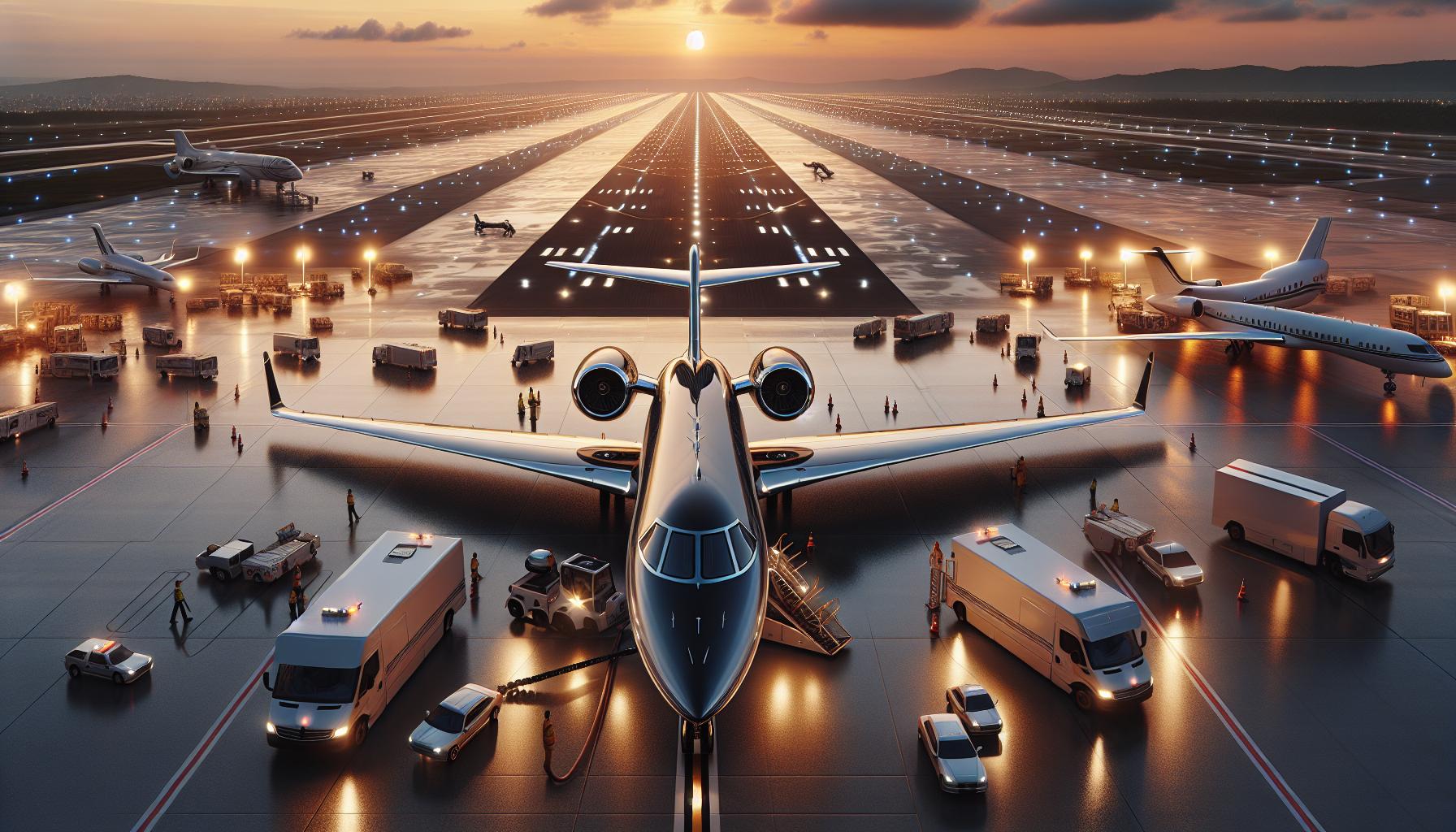
Ever wondered what it costs to live the high life, soaring through the skies in your own private jet? I’ve got the inside scoop for you. With my experience in the private jet biz, I’ve seen firsthand what it takes to keep these luxurious birds in the air.
The allure of skipping long security lines and cramped commercial flights is undeniable. But what’s the price tag for this exclusive convenience? I’ve done the legwork and crunched the numbers to give you a clear picture of midsize private jet costs per hour.
What is a midsize private jet?
Before diving into the costs, let’s get clear on what a midsize private jet really is. I’ve been around these beauties enough to know they’re the perfect balance between luxury and practicality. Midsize jets hit the sweet spot for travelers looking for comfort without going over the top.
Typically, these jets accommodate around 8 to 10 passengers and are designed with spacious cabins. I’ve flown in quite a few, and there’s always enough room to stand up and move around. That’s a game-changer on longer flights. They generally have a range of about 2,500 to 3,500 miles, which means coast-to-coast travel is well within reach without any pit stops.
Let’s talk about speed. Midsize jets aren’t just roomy – they’re quick. With cruising speeds of approximately 500 miles per hour, they significantly cut down on travel time. That means less time in the air and more time enjoying your destination.
Here’s a rundown of their typical features:
- Adjustable leather seats that can swivel and recline
- A galley for meal prep
- Private lavatories
- In-flight entertainment systems
- Wi-Fi and communication equipment
Durability is also a part of their charm. Midsize jets are built to handle frequent use, making them a favorite for businesses and individuals who travel often. They’re tough, reliable, and, thanks to their size, can land at airports that larger jets can’t, giving you more flexibility in your travel plans.
It’s easy to see why a midsize jet is a go-to choice for those looking to travel in style and comfort. Now, let’s switch gears and focus on what it takes to keep these birds flying.
Factors that affect the cost per hour

When you’re looking into hiring a midsize private jet, you’ll find that costs can vary significantly. I’ve learned that several key factors play a role in determining how much you’ll pay per hour. Here’s what you need to know.
First off, fuel expenses are a major component of the hourly rate. With the fluctuation of fuel prices, rates can change from one month to the next. Next, the age and model of the aircraft influence the cost, as newer jets with the latest technology tend to be pricier.
Crew salaries also add to the operating costs, and this includes not only the salaries of the pilot and co-pilot but also the cost of any additional staff, such as flight attendants. Here’s something not everyone considers: landing fees and ramp fees. Different airports charge different rates, and these can impact the hourly cost, particularly if you’re flying into a major city’s airport.
Another thing to keep in mind is the maintenance and upkeep of the jet. Midsize jets, while durable, still require regular maintenance to keep them flying safely and smoothly. This maintenance isn’t cheap and is factored into the hourly cost.
How often the jet is used or its flight hours can also affect cost, as the more a jet is flown, the more maintenance it typically requires. And don’t forget insurance. Premiums to insure these valuable aircraft are factored into your hourly rate as well.
Lastly, you’ll find that duration of flight can influence costs, with shorter flights typically having a higher per-hour rate compared to longer flights due to the costs associated with takeoff and landing being spread out over a longer period.
Here’s a quick look at these factors:
- Fuel costs
- Aircraft age and model
- Crew salaries
- Landing and ramp fees
- Maintenance and upkeep
- Flight hours
- Insurance rates
- Duration of flight
Understanding these variables will give you a much clearer picture of what you can expect to pay when chartering a midsize jet. Remember, while some of these costs might seem steep, the convenience, comfort, and luxury that come with flying private are often worth the investment.
Average cost per hour for midsize private jets

When you’re looking into the costs of chartering a midsize private jet, you’ll find that prices vary, but there’s an average range you can expect. On average, you might be looking at anywhere from $2,000 to $3,500 per flight hour. But let’s not forget this is just an average. Actual costs can swing depending on a variety of factors I’ve mentioned before – things like fuel prices, crew salaries, and the jet’s age can play huge roles in the final tally.
To give you a better grasp of the numbers, I’ve drawn up a quick table that lays out some of these average hourly costs. It’s worth noting these figures are subject to change as market conditions fluctuate:
| Jet Type | Average Cost Per Hour (USD) |
|---|---|
| Light Jet | 2,000-2,500 |
| Midsize Jet | 2,000-3,500 |
| Large Jet | 4,000-8,000 |
It’s not just the type of jet that affects the cost. Years of experience have taught me that the add-ons and specialized services significantly impact your bottom line. Want a gourmet meal or a specific brand of champagne onboard? That’s going to bump up the price. How about Wi-Fi or in-flight entertainment? Yep, these conveniences also add to the cost.
What’s crucial to remember is that these rates cover more than just the jet itself. They encompass the full package: the convenience, speed, privacy, and luxury that come with private aviation. Plus, the flexibility of creating your own schedule – priceless for those with time-sensitive business or personal commitments.
Thinking about how these costs fit into your budget? Keep in mind that while you might shell out more per hour for a larger or newer jet, the time savings and on-board experience often offset the expense. Opting for a slightly older model can be a savvy way to save, as long as it meets your standards for comfort and safety.
But, beyond just the numbers, consider the value of what you’re getting. Think about the unparalleled experience of jet-setting across the skies in a space that’s entirely yours. Flying private isn’t just a travel alternative; it’s a statement – one that speaks volumes about what you value: efficiency, privacy, and a touch of indulgence.
Additional costs to consider

When you’re budgeting for a private jet experience, there’re a few extra expenses that you’ll need to keep in mind. These aren’t hidden fees, but rather parts of the journey that can affect the overall cost.
Landing and Handling Fees: Every time a jet lands at an airport, there are fees associated. They cover everything from parking the aircraft to passenger service charges. They can vary widely based on the airport and the time spent on the ground.
Catering Costs: Private flying isn’t complete without the right food and drinks. If you’re looking for anything beyond standard snacks and beverages, it’ll cost extra. Gourmet meals and fine wines will definitely bump up your bill.
Overnight Fees: Should the crew have to stay overnight at a location, you’ll be footing the bill for their accommodations and per diem. Think of it as covering a mini-hotel stay for your flight team.
International Travel Charges: Flying abroad? You’ll encounter a slew of additional charges like overflight permits, international handling, and customs fees. These costs can quickly add up, depending on your destination.
Deicing Costs: In colder climates or seasons, your jet may need to be deiced prior to takeoff. This is a safety must, but it’s also an additional cost that you might not have thought of initially.
Remember, these costs can vary and might be rolled into your overall charter quote. It’s always best to ask for a detailed breakdown so you’re not caught off guard. I always recommend doing so to make sure you’re fully in the loop.
Wi-Fi Charges: Staying connected at 30,000 feet isn’t always free. If you need internet access during your flight, check if it’s included or how much it will cost you additionally.
Ready to tailor your flight experience? Keep these points in mind and you’ll be better equipped to manage your private jet charter costs effectively.
How to save on private jet costs

When it comes to private flying, the savvy traveler knows that there are ways to keep costs down without sacrificing the luxury and convenience. I’ve gathered some tried and true strategies to save money while still enjoying the high life at 30,000 feet.
Fly During Off-Peak Times can make a massive difference in charter rates. Just like hotels and conventional airlines, private jet companies often offer lower prices during less busy times. Think mid-week flights and avoiding major holidays. It’s also worth considering empty leg flights, which are trips made by the aircraft to return to its home base or position to its next client. These can offer substantial discounts, sometimes up to 75%. However, be mindful that these options may require flexibility with your travel plans.
To make the most out of your investment, consider shared flight programs or joining a jet card membership. With shared flights, you’re essentially splitting the cost of the trip with other passengers. Jet cards, on the other hand, work like a debit card for private air travel, often providing lower rates and additional benefits.
Opt For Smaller Airports if possible. Bigger airports come with higher landing fees, and by choosing to land at smaller, less busy airports you can cut down on these costs. Plus, you’ll often enjoy a quicker turnaround and less ground traffic.
Don’t overlook the power of negotiation. Always ask the charter company if there’s any room for discounts or package deals, especially if you’re planning to fly frequently or book round trips. It’s my experience that operators are keen to ensure customer satisfaction and loyalty, which can translate into better deals for you.
When you’re planning your trip, also think about the duration of your stay. Overnight fees for the crew can add up quickly, so taking day trips or flights that don’t require a layover can be more cost-effective.
Remember, the goal is to enjoy the benefits of private jet travel without unnecessary expenses. Keep these tips in mind and you’re well on your way to more affordable journeys through the skies.
Conclusion
Frequently Asked Questions
What is the best time to fly to save on private jet costs?
Flying during off-peak times can significantly reduce private jet costs as demand is lower, resulting in more affordable rates.
Are there ways to save money on last-minute private jet flights?
Yes, considering empty leg flights, which are discounted trips returning the plane to its home base or next destination, can offer significant savings.
How does joining a shared flight program or jet card membership reduce costs?
Joining shared flight programs or jet card memberships can offer reduced rates, allowing passengers to share costs or buy flight time at fixed rates, respectively.
Can choosing smaller airports affect the cost of private jet travel?
Opting for smaller, less busy airports can reduce landing fees and ground services costs, thus trimming the overall expense of private jet travel.
Is it possible to negotiate discounts on private jet flights?
Yes, negotiating for discounts, especially when booking multiple flights or during low-demand periods, can result in lower private flight costs.
Does planning non-overnight trips influence private jet pricing?
Planning trips without requiring overnight stays can save money as it avoids crew accommodation and additional airport parking fees.
